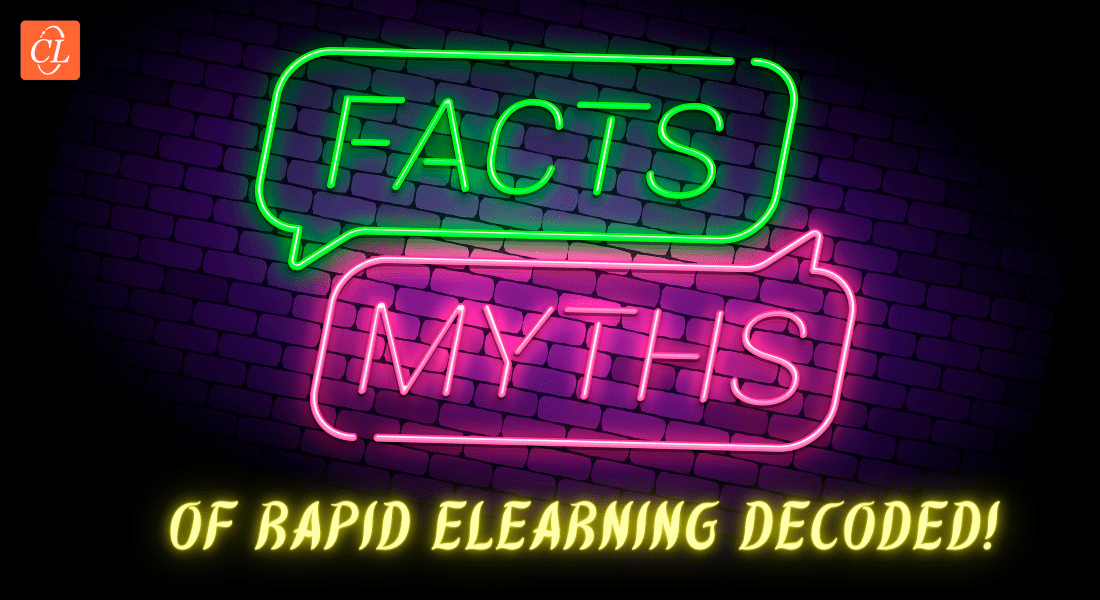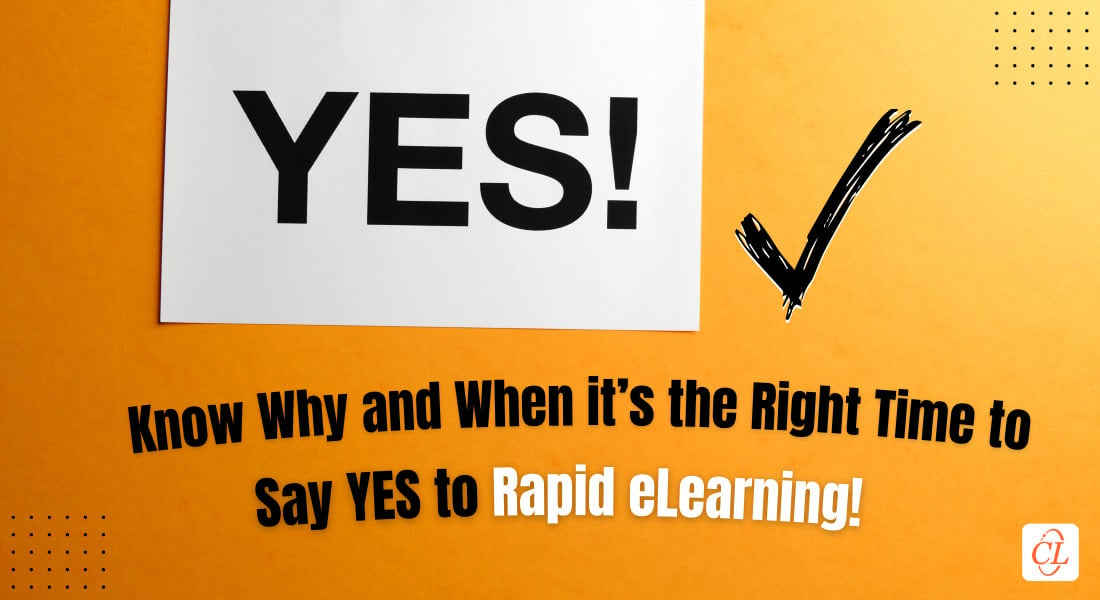Let’s Debunk 6 Myths Around Rapid eLearning!

Creating eLearning courses and providing the required training within the set timeframe and a fixed budget is an achievement for learning and development experts. But how do we do that? Rapid eLearning is a training solution that comes to mind when we need to overcome time and cost barriers.
Also, comes to mind a few misconceptions about rapid eLearning. Rapid eLearning has been the talk of the town for quite some time now, however, there are still some misconceptions surrounding it. Some might say that it is a quick fix to plug gaps in learning and training. Some might also say that being cost and time-efficient, rapid eLearning compromises quality. But, is it true? Let’s find out!
Bringing the Truth Forefront and Debunking Myths Around Rapid eLearning
Here are 6 Myths About Rapid eLearning:
- Myth 1 – It is Complicated and Demands Advanced Technical Expertise
- Myth 2 – It Compromises with Quality
- Myth 3 – It Lacks Creativity
- Myth 4 – It Does Not Require SMEs Intervention
- Myth 5 – It is Difficult to Track Course Development
- Myth 6 – Its Content is not Future-proof
I agree that rapid eLearning avoids the additional frills and fancies however it never compromises the quality of learning. In this blog, let me debunk a few myths surrounding rapid eLearning. Let us look at the other side of the coin and explore that rapid eLearning is much more than what we think.
6 Myths About Rapid eLearning and Their Reality
Myth 1: Rapid eLearning Development Process is Complicated and Demands Advanced Technical Expertise
Reality
Well, that is a big NO! Rapid eLearning is based on robust instructional design principles and hence can deliver effective learning. It is a misconception among many that you need advanced technical expertise to develop rapid eLearning courses. Now, this is far from the truth. The accessibility to authoring tools such as Articulate Storyline 360 and Adobe Captivate has made rapid eLearning development easier than ever. These tools also have many built-in elements to make your task hassle-free. What you need is a practical idea of MS word and PowerPoint and knowledge of working on authoring tools, and you can create some effective rapid eLearning courses.
Here are the best practices for instructional designers to utilize rapid eLearning for maximum results.
Myth 2: Rapid eLearning Compromises with Quality
Reality
I agree that rapid eLearning does away with the frills however in no way it compromises the quality of learning. Rapid eLearning utilizes the built-in templates, multimedia assets, and features of authoring tools to develop and roll out courses in lesser time. Now, that the development speed is accelerated, it does not mean that the quality is decreased. Rapid eLearning follows an agile and iterative process for development, which includes quality checks at each stage of development to ensure interactive and engaging eLearning courses.
Myth 3: Rapid eLearning Lacks Creativity
Reality
If creativity means adding frills and colors to make learning attractive, then I am sorry to burst that bubble, but that is not true. Creativity means developing courses that save resources like time and cost and at the same time engage learners. Rapid eLearning uses creative instructional design strategies like storytelling, gamification, scenarios, etc. to make learning highly engaging, effective, and immersive. All that and also saving time and cost! Now that’s what creativity is!
Myth 4: Rapid eLearning Does Not Require SMEs (Subject Matter Experts) Intervention
Reality
Well, again that is not true. Unlike what the misconception is, SMEs are the main people who play a very important role in guiding instructional designers. SMEs ensure the accuracy of the course content. SMEs work very closely with instructional designers to finalize the content, share ideas on the design, and review developed courses. They are involved throughout the course right from sharing their input, reviewing the courses, and final sign-off.
Myth 5: Rapid eLearning Development Process is Difficult to Track
Reality
It may come to mind that creating rapid eLearning courses is a short and crisp process and hence it is difficult to track the course development. However, that is not the case. Rapid eLearning follows an agile project management process and hence each development phase is meticulously planned and development can be easily tracked. It is ensured that there is constant communication between the stakeholders and the design team while following an iterative process.
Myth 6: Rapid eLearning Content is Not Future-Proof
Reality
Rapid eLearning offers ease of updating learning content with rapid authoring tools ensuring that your learning is future-proof. With new updates almost every day, content needs to be frequently updated, because of rapid authoring tools, rapid eLearning ensures that content can be changed easily and kept updated.
Parting Thoughts…
There are many such misconceptions about rapid eLearning however this is far from the truth. Rapid eLearning is now a go-to solution for many when it comes to tight deadlines and stringent budgets, all of it while maintaining quality. Rapid eLearning does not happen in a blink of an eye, developing and implementing rapid eLearning required meticulous planning, akin to any other training solution.
While all these misconceptions surround rapid eLearning, let me assure you that rapid eLearning is here to stay and is not a temporary solution. It is instead a robust procedure addressing major training needs. Do you want to dive deep and explore more about the rapid eLearning development process? Grab this eBook and get an overview of the rapid eLearning development process.





